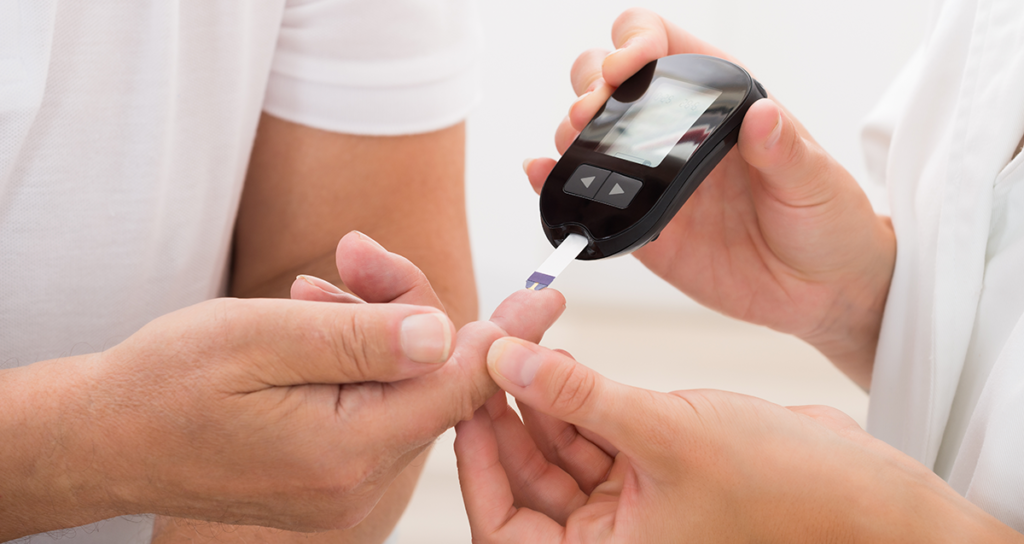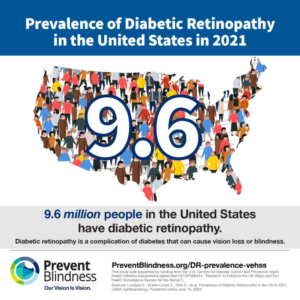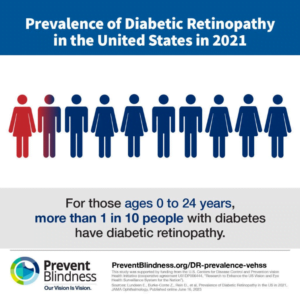
Exploring the Alarming Rise of Diabetic Retinopathy Cases
Diabetes-related eye disease has become substantially more prevalent in the U.S. since the last estimation in 2004, a new study published in JAMA Ophthalmology suggests. An estimated 9.6 million people in the U.S. (26.43% of those with diabetes) have diabetic retinopathy (DR), while 1.84 million people (5.06% of those with diabetes) have vision-threatening diabetic retinopathy (VTDR). Compared to the last estimation in 2004, the new study suggests that people in the U.S. over 40 living with diabetes-related eye disease have more than doubled in less than two decades. The prevalence of VTDR nearly doubled as well in that same period. Those figures could grow in the coming decades if we, as doctors and patients, are not proactive in our eye health.
This critical study, supported by Prevent Blindness and authored by physicians at the U.S. Centers for Disease Control and Prevention, the Institute for Health Metrics and Evaluation, the University of Washington, and the NORC at the University of Chicago, is one of the most comprehensive to date on the prevalence of diabetes-related eye disease in U.S. populations. While past estimates had only factored in people in the U.S. over 40, these new estimates are the first to include the prevalence of DR and VTDR in people younger than 40. Not only did the study include all working-age adults in the U.S., but it also segmented those estimations by 5-year age gaps, gender, race, ethnicity, and U.S. state.
Key findings showed VTDR is more prevalent in Black (8.7%) and Hispanic (7.1%) individuals than White individuals (3.6%). Prevent Blindness warns in its press release that “a higher percentage of Black and Hispanic individuals with diabetes are at risk for vision loss compared to their White counterparts.” Moreover, the study showed a wide range in prevalence of DR and VTDR among states, with a low of 21.2 percent in Nevada to a high of 34.2 percent in Hawaii. With age, DR and VTDR increased substantially before dropping dramatically in the oldest age groups. Potentially, there is a correlation between DR and VTDR and early mortality since such eye diseases are markers of severe diabetes.
“[These findings are] driven primarily by the large increase in diabetes in the United States that has occurred over the last 20 years and underscores the importance of prioritizing eye care and diabetic retinopathy screening among people with diabetes,” said researcher David Rein, a senior fellow, and director of the Public Health Analytics Program at NORC at the University of Chicago.
“The number of diabetes cases in America continues to grow, and with that, so are the damaging effects on vision,” Jeff Todd, President and CEO of Prevent Blindness, said. “It is our hope that this new data will guide us to successful interventions and improved outcomes for those with diabetes.
Increasing Prevalence of Diabetes
“This study is, unfortunately, a potent reflection of the epidemic that diabetes is in the U.S.,” says Dr. Leonard Ginsburg, Chairman of Moore Eye Institute, Chairman of the Ophthalmology Residency Program at Philadelphia College of Osteopathic Medicine, former Clinical Chief of the Department of Ophthalmology at Drexel University College of Medicine, and one of the only retina specialists in the U.S. also to be certified as a Diabetes Educator for nearly 20 years. “As is evident, in too many ways, we’re going backward rather than forward. With massive improvements in treatments for diabetic eye disease, one would expect the prevalence of vision-threatening diabetic retinopathy to have decreased over the last two decades. Clearly, that is not the case.”
When discussing what we could do to lessen the rise, Ginsburg said, “We need to double down on our preventative efforts, including earlier screenings, more regular photographs, and potential lifestyle changes. Moreover, we need more diabetic education programs where physicians, allied health professionals, nutritionists, and exercise physiologists join to discuss better practices for early intervention and preventative methods to keep patients’ Hemoglobin A1C in check so they either don’t get DR or their DR does not progress. It behooves all physicians and patients alike, to work together in tackling this national epidemic.”
Addressing Alarming Growth of Diabetic Retinopathy with DHRpro
DHRpro helps practices identify lost to follow-up patients much more effectively than any recall system possibly could. We help medical practices identify patients who need care based on high-risk diagnoses, procedures performed, or any other parameter you specify. Then send a task to your office staff to schedule those patients ASAP.
With DHRpro, your practice can filter through your patient population to identify which patients have diabetes-associated eye diseases, so you can ensure that they are visiting your office as much as is needed and receiving the proper care to sustain their eye health.




